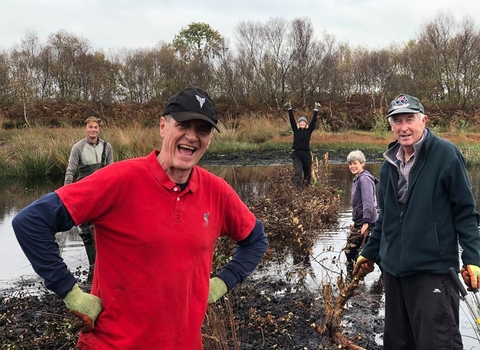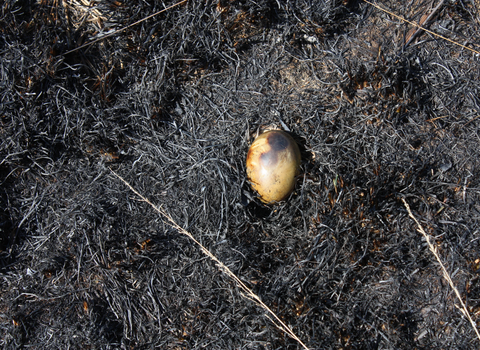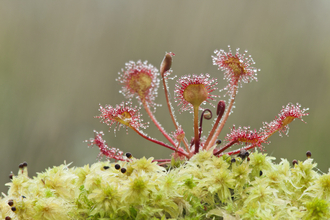Winmarleigh Moss SSSI - credit Lancashire Wildlife Trust
The Lancashire Peatlands Initiative
Restoring peatland habitats
98 per cent of the precious peatlands in Lancashire, Manchester and North Merseyside have been destroyed – and the remaining two per cent are in trouble.
Our peatlands have been affected by drainage, historic cutting of the peat for fuel, conversion to agricultural land, management as shooting estates, and even commercial peat extraction for use in horticulture. The remaining slivers of peatland are degraded and fragmented, so we are working hard to restore and reconnect them.
What do we do?
Lancashire Wildlife Trust has been working on peatland restoration in Lancashire, Manchester and North Merseyside for over 20 years, managing a number of Sites of Special Scientific Interest and Special Area of Conservation sites, totalling around 200 ha, both owned by the Trust and on behalf of local authorities. We take an active role in advocacy for all peatlands, including as the lead partner of the Lancashire Peat Partnership and the Northern Lowland Peatland Coalition.
Peatland sites that the The Lancashire Peatlands Initiative looks after includes:
Astley & Bedford Moss | Cadishead Moss | Heysham Moss | Highfield Moss | Holiday Moss | Little Woolden Moss | Red Moss | Rindle Moss | Winmarleigh & Cockerham Moss
We are working hard to bring these, and many more, amazing peatland habitats back to life. We are also working with various partners and landowners across our region to explore the sustainable management of peat soils elsewhere and reconnect our fragmented peatland landscape, to ensure the future of our precious peatlands.
Why are our peatlands so important?
Spread the word
One of our main objectives is to shout out about how amazing our peatland habitats are and what we can all do to protect them.
A simple change that we can all make is to go peat-free in our gardens and support our #PeatFree campaign. Making the switch to peat-free compost and ensuring that plants and turf that you buy haven’t been grown in peat could help to save huge areas of remaining peatlands across the world from being dug up simply to fill cheap bags of compost.
We are also campaigning to change the attitudes of other businesses, organisations and policymakers. We are working to engage retailers in the peat-free movement and lobbying to change policy in favour of peatland restoration. Further to this we are active members of the Lowland Peat Agricultural Task Force, looking at alternative land management methods for peat soils and are engaging in research and trials into ‘wetter farming' methods which could help protect our precious peatlands.

We are working to encourage everyone to take action for peat.
Our peat action pack is stuffed full of handy hints and tips to help you go peat-free at home, and make a difference to the future of our precious peatlands.
Whether you choose to go peat-free at home, encourage others to follow suit, sign petitions, lobby retailers or contact your MP, there is so much that everyone can do to make a real difference.

Our volunteers are vital to the future of our peatlands - credit Lancashire Wildlife Trust
Engaging local communities
Our members and supporters are incredibly important to us. We are working with local community groups and volunteers to help restore and protect our peatlands.
Check out our events page for details of guided walks and other community events, educating people about our precious peatlands and giving them a chance to experience these amazing landscapes first hand.
We are very lucky to be supported by the Friends of Chat Moss. Check out their Facebook and Instagram pages for details of how you can get involved.
You can also register to become one of our amazing LWT volunteers.
But we can't do it all on our own...
Partnership working is vital to the success of peatland restoration in our region. Our peatlands sit under various ownerships and there are a number of organisations who are all working hard to save them, so we work in collaboration to bring all of this work together.
The Lancashire Peatlands Initiative is the lead partner in:
Lancashire Peatland Partnership | Northern Lowland Peatland Coalition
We are also active members of:
Great Manchester Wetlands Partnership | Great North Bog Coalition | Care-Peat
Our projects
The Lancashire Peatlands Initiative will be working on a number of projects at any one time. Current projects include:
Want to find out more?
We’re passionate about peat and love to talk about it!
Sarah Johnson - Lancashire Peatland Initiative Project Manager
E: sjohnson@lancswt.org.uk
T: 01772 324223

The Lancashire Peatlands Initiative is funded by the Esmee Fairburn Foundation.
Further funding and support is provided by companies and organisations including:
Biffa Award | DEFRA | Environment Agency | EcoSpeed | Hamilton Davies Trust | Heritage Fund | Interreg NW Europe | Lancashire Environmental Fund | Mace Group | Natural England | Salford City Council | Salford CVS | Standby Productions | Tyrer Ecological Consultants | Veolia Environmental Trust | Viridor Credits | Wigan Council
Further resources
Find out more about the work of the Lancashire Peatlands Initiative.
Research
Many of our projects include ongoing monitoring and research. This helps to provide the data required to prove the positive effects of peatland restoration and the alternative land management of peat soils. Examples of this include:
Care-Peat
We are working with knowledge partners, Manchester Metropolitan University, to monitor the greenhouse gas emissions from our carbon farm site, and a companion planting trial at Little Woolden Moss. Both sites have already shown significant reductions in CO2e emissions resulting from the restoration and re-wetting works.
We are also benefiting from the multi-partner, multi-country working of Care-Peat which will deliver other research outputs including socio-economic data and decision making tools.
Wetter farming feasibility study
Lancashire Peatlands Initiative Project Manager, Sarah Johnson, authored a feasibility study into wetter farming on lowland agricultural peat soils in the North West river basin. The results will be fed into the work of DEFRA's Lowland Peat Agricultural Task Force, that is looking at how lowland peat that is currently intensively farmed can be managed in a more climate-friendly way in the future, helping the UK to reach our net zero goals.
The LPI team are also leading on other wetter farming trials in Greater Manchester and Lancashire, which are looking at higher water table management of peat soils and the socio-economic viability of alternative crops.
Species reintroduction
The Great Manchester Wetlands species reintroduction project involves extensive monitoring of peatland habitat to assess it's suitability for the reintroduction of lost species. We also undertake species monitoring to identify which species are benefiting from our restoration works and which species require further support.
Greater Manchester Peat Pilot
The LPI was involved in the Natural England's England Peat Strategy: Greater Manchester Peat Pilot Report for Defra (published 2020), which primarily focused on carbon emissions from peat under current and alternative land use scenarios. The report highlights the following statistics:
- Overall, peatlands in Greater Manchester are emitting in the region of 180,000 tonnes of CO2e every year, equivalent to the annual emissions of around 10,000 UK households.
- Half of these emissions were coming from a single site, the lowland peat mass of Chat Moss. Almost 90 per cent of the Chat Moss emissions were from intensive land uses that rely on peatland drainage.
- Moving these intensive land uses to wetter forms of agriculture, including carbon farming, could reduce these emissions by up to 90 per cent.
- In the uplands, wildfire is a significant problem, but risk and damage from fire can be greatly reducedby improving the condition of our upland bogs.
Finance
Peatland restoration simply cannot happen without the funding required to undertake it. At The Lancashire Peatlands Initiative we are working to look at innovative ways to make this happen. Along with the traditional grant funding streams, we are at the forefront of developing new and more diverse income streams for peatlands in the region. This could include blends of public and private finance, so both corporates, businesses and organisations could fund peatland projects as part of CSR or carbon compensation schemes, alongside government subsidies and other funding.
We are delighted to be supported by businesses including EcoSpeed Couriers, Mace Group, Standby Productions Ltd and NTB Survey.
Successes
The Lancashire Peatlands Initiative won the CIEEM 2021 Best Practice award for Practical Nature Conservation in recognition of our work in delivering pioneering and nationally significant habitat restoration which has led to the successful reintroduction of the large heath butterfly to the Manchester mosses after an absence of 150 years.
Peatlands in Lancashire
History of Chat Moss
Chat Moss in Greater Manchester was once one of the largest areas of lowland raised peat bog in the country. However years of drainage has taken it's toll, leaving 99 per cent of Chat Moss degraded. We have been looking into the history of Chat Moss:
- Video: What happened to Chat Moss?
- Blog post: Great Woolden Iron Age Roundhouse site
- Blog post: Who was Worsley Man?
- Webinar: The prehistoric archaeology of Chat Moss









